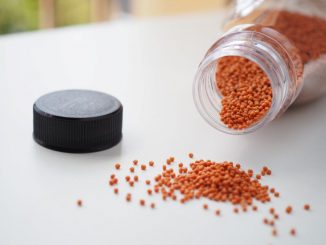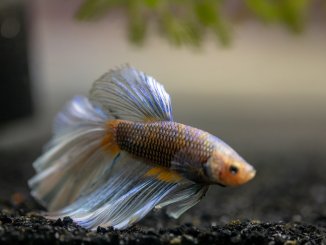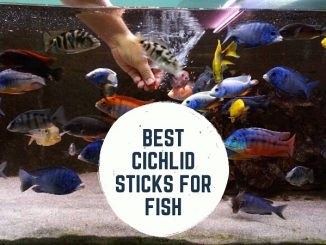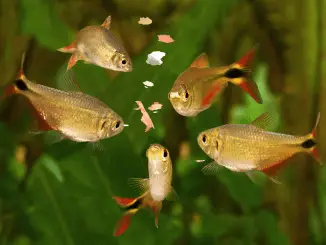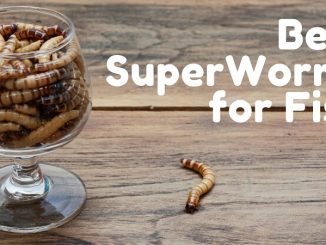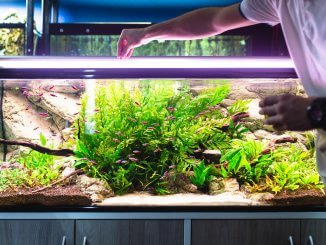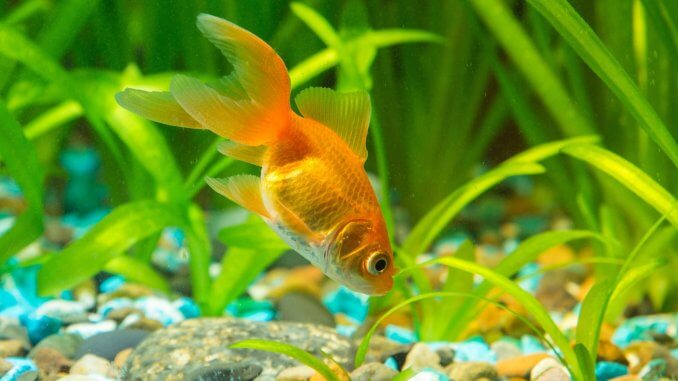
With goldfish one of the most important aspects of keeping them healthy is their nutrition.
They require a well thought out and varied diet to ensure they are getting all the nutrients they need.
Finding the right goldfish food can be a fun challenge for you.
From flake to pellets to gel food, the alternatives of what to feed them are varied and numerous.
Keep reading if you want to know more about how best to feed your goldfish, and which foods we recommend.
TABLE OF CONTENTS
How To Choose Goldfish Food
There are several things that you should consider when deciding on the best food for your goldfish. The most important thing to think about is the nutritional value that the food you are buying can offer your fish.
Generally speaking, goldfish are flexible with their diet. From pellets to flakes to live food and homemade recipes, ultimately, you should choose what best suits the needs of your fish.
As nutrition goes, commercially prepared food can be very good – you just have to know what to look for.
Reading Food Labels
When looking at different diets, you should always start from the basics and consider the nutritional value and advantages that a particular food can offer to your goldfish. You can do this by looking at the breakdown of proteins, fats, fibers and carbohydrates.
Fish need energy to grow, reproduce and heal Therefore, a balanced diet offering the optimal energy intake is essential for their wellbeing.
Carbohydrates are one of the most important parts of their diet. Some food companies often add table sugars (sucrose) or plant matter such as green peas that contain a variety of complex and simple carbohydrates.
Proteins are also fundamental. A high protein diet has been shown to be beneficial.
Fibers can help prevent digestion problems in your goldfish.
You should avoid soy and grains, as grains such as barley, rice, wheat flour and wheat gluten (anything with gluten) don’t belong in their diet.
Fish meal can also cause difficulties. Try to avoid buying leftovers from processed food such as fish bones, scales and fins, etc.
Whole proteins should be included, and they should always come from the marine or freshwater environment.
Ultimately the key is having a varied and balanced diet whether with homemade recipes or commercial food.
Best Goldfish Food
When buying goldfish food, you have a huge range of choice – there is no right or wrong answer. It depends on your budget and the preferences of your fish.
Generally speaking, their food can be divided into fresh, live food and dry food. Goldfish are usually fed with dry foods such as flakes, pellets and gel.
You will find lots of dry food choices. You should find the right one that suits the needs of your fish. If you have more than one, you might require different types of food for different goldfish varieties.
Some foods float and some sink, however these fish usually occupy all levels of the water column and will happily graze at the surface or on the substrate.
Flakes
TetraFin Goldfish Flakes
This specially formulated goldfish food meets all the nutritional requirements for your fish. They hold their shape when the get wet and they don’t cloud the water.
Flakes usually float on the surface of the water, then break up and sink to the bottom. Keep in mind that it’s very easy to over-feed goldfish with flakes and if you find yourself with leftover uneaten food in the water it will be hard to maintain good water conditions.
Some aquarists soak the food before feeding as it is easier to digest.
Flakes can sometimes cause problems. As the fish gulp at air while they are feeding on the floating flakes, they can occasionally take in too much air too.
Pellets
Hikari Fancy Goldfish Pellets
This professional high quality pellet food has been specifically designed for fancy goldfish, and it helps to bring out their colors.
Pellets generally sink straight to the substrate. They dissolve slowly meaning your fish have plenty of time to eat their food. You can also find the floating variety, although floating pellets are not very common.
Usually, if your fish is sick, they will prefer eating sinking food. For this reason, keeping a reserve of pellets is always a good idea.
Remember as most dry food, pellets will expand when soaked in water, so if your fish eats the pellets before they expand this can cause problems with digestion. For this reason, you might want to soak the pellets before adding them to your goldfish tank.
Gel
On the whole, gel food is the best for goldfish, especially if you keep a fancy goldfish. Many aquarists prefer using gel food for a number of reasons but the preferred one is that gel food is moist. In the wild fish are used to eating wet foods so this most naturally replicates their wild diet.
You can soak dry food before feeding your fish, but this can sometimes cause cloudy water and the loss of some nutrients.
With gel goldfish food, gelatin is used to bind the different ingredients together. This food is generally easier to digest for your goldfish and will not pollute the aquarium if left uneaten for too long.
You can buy pre-bought powder and then make up enough gel food as you go. You can refrigerate it or freeze it to preserve it.
Treats You Can Give Your Goldfish
The key to a healthy goldfish is to provide them with a balanced and varied diet. They will benefit from the occasional treat and the extra nutrition they provide. Goldfish are primarily herbivores, but they need some meat in their diet still.
Meaty foods are a great way to provide them with a protein treat. There are many options, from live to frozen foods. Just remember treats should be fed once a week.
Freeze Dried Foods
Freeze Dried Bloodworms
Bloodworms contain a high amount of protein which is perfect for your goldfish. Also known as red mosquito larve, this food is ideal for your top-feeding goldfish as they float at the surface of the water for a while before sinking.
Often they are only available in chunks and you will need to break them up for younger fish.
There are many varieties of food that you can findL Daphnia, plankton, tubifex worms, shrimps are fundamental sources of nutrition.
Live Foods
Live food is a fantastic source of protein, especially for juveniles who are still growing and need lots of energy. The most popular choice is brine shrimp.
Other popular choices are daphnia, tubifex worms, glass worms and snails. Make sure any live foods you introduce to your aquarium, are clean before feeding them to your fish.
There are also a number of live plant based foods which you can give to your fish. Live aquatic plants such as duckweed are easy to grow and provide great nutrition.
Frozen Foods
You will find that most live foods are also available in frozen form. Frozen food has a major advantage – there is very little risk of infection.
From brine shrimps to bloodworms, krill to squid and algae, frozen food can meet all the dietary requirements of your goldfish.
Krill is particularly good for carotene levels, the red pigment will improve their colors.
Frozen foods tend to have slightly less nutrients than live foods do, and they will need thawing before feeding times.
Fresh Foods
To keep your goldfish healthy, you can also feed them vegetables. Zucchini, broccoli, potatoes and peas are all great choices – just remember to be boil or blanch them first.
Greens are particularly good for sick goldfish who are struggling with their swim bladder.
No matter what you are giving them, always try to soften the food before feeding time.
How To Feed Goldfish
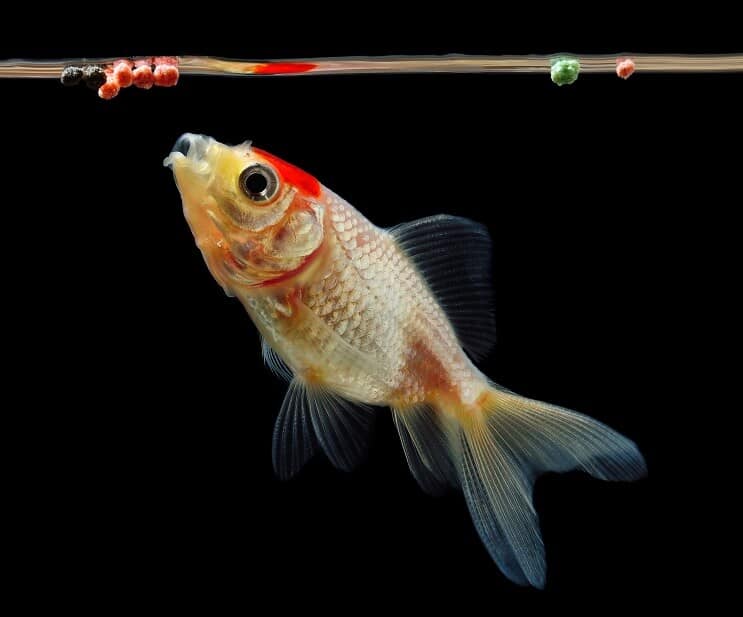
Remember less is better.
Generally, you should feed your them no more than what they can eat in 2-3 minutes per feed. Try to always remove the uneaten food.
Temperature can play a major role in deciding how much to feed your goldfish as low temperatures can slow down their metabolism.
Remember, less is better. Over-feeding them is one of the most harmful things you can do. Your goldfish won’t stop feeding as long as there is food available. Overfeeding will cause blocked intestines and swim bladder problems.
A good indicator of this is the long trail of poop left behind by your fish. If you notice it, your fish has probably over eaten.
As your goldfish cannot have too much food all at once, you should have several feeding sessions per day. The more the feeding sessions the less food you should give them during each time.
There is no ultimate way of doing this as different fish requires different things. A good reference point is feeding them 2 to 3 times per day with enough food that they can consume within 2 minutes.
Depending on their feeding needs you should provide enough food to be consumed in 5 or 6 minutes in an entire day.
FAQs About Goldfish Food
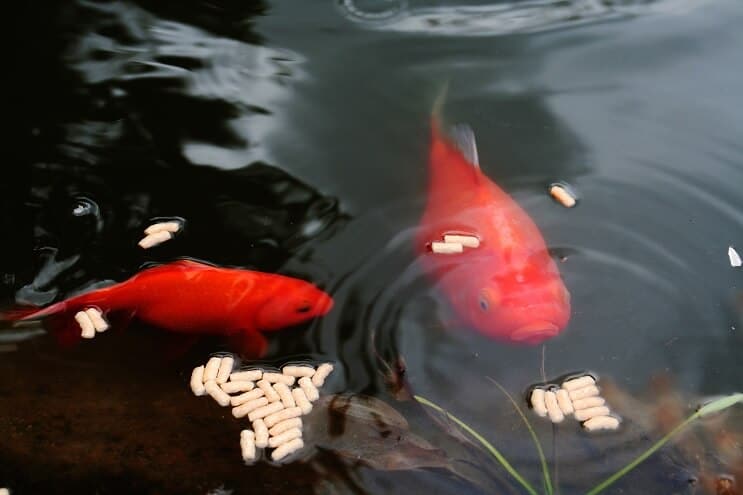
How Long Can Goldfish Go Without Food?
Goldfish are surprisingly hardy fish and can survive for a long time without food. The longest a goldfish has been known to go without food is 134 days.
Can Goldfish Eat Tropical Fish Food?
Food for tropical fish is very similar to goldfish food and generally can provide similar nutrition in the short term.
However, tropical fish need more proteins and fewer carbohydrates. Therefore, Goldfish will not do very well long term on this diet and it will be very detrimental to their health.
Can Goldfish Eat Betta Food?
Put simply, no.
Betta and goldfish are very different fish, from their digestive tracks to their feeding habits. Goldfish have a slow and long-term digestion and are omnivores. Whereas bettas are carnivores and need a high protein diet.
Why Is My Goldfish Not Eating?
This is usually due to water quality or disease.
If you notice that your goldfish is swimming in a strange way (from swimming sideways to floating upside down) it probably has swim bladder disease from over eating.
Another reason could be constipation – you will notice this if your goldfish swims at the bottom of the tank, scooting along. In both cases no food for 48 hours or cooked peas.
Summary
Hikari Fancy Goldfish Pellets
This professional high quality pellet food has been specifically designed for fancy goldfish, and it helps to bring out their colors.
You want to feed your goldfish food that meets their dietary needs.
Remember can also give them the occasional treats – these are a must for a healthy and happy fish.
Overfeeding is one of the biggest dilemmas. How much is too much or not enough? In this case less is better. Overfeeding can cause serious problems that are not always easy to solve.
Which food does your goldfish prefer? Leave a comment below…




